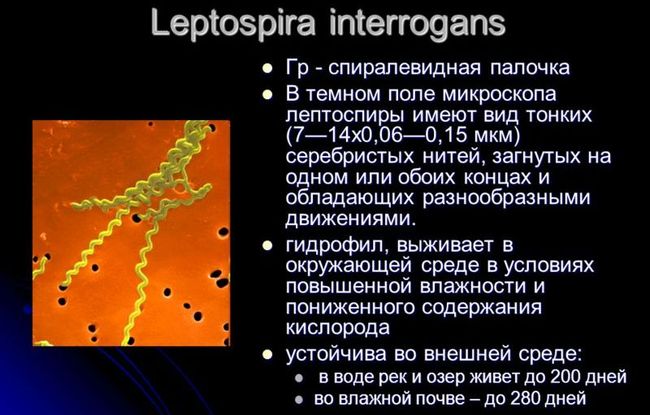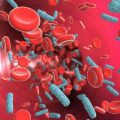Leptospirosis in humans - an infection, wearing many different names. for example, it is known as Weil's disease-Vasileva, or as a dog, water, Japanese day fever. Regardless of the name, underneath is hiding parasitic defeat of the human body representatives Leptospira family.
Symptomatology of the disease confused with a variety of pathological conditions. Often it is perceived as an ordinary flu, but the disease significantly affects the immune system. Over time, leptospira cause intoxication and heavily damaged many organs.
In severe cases, the disease can result in jaundice, meningitis or even renal failure. Luckily, if you know the symptoms and treatment of this pathology, it will be possible to prevent the particularly serious consequences.

Pathogen and features of the course
The causative agent of leptospirosis is the Leptospira interrogans coli. In the world it is represented in more than 210 species. This microorganism is different weak resistance to the adverse effects of the environment. for example, bacteria can die from ultraviolet rays.
pathogen Features:
- Getting in dry soil, leptospira survive no longer than a couple of hours.
- In wet conditions, their life span increased almost up to a year.
- They fear harm fever, but precisely because of the low they can easily wait out the winter in the ground directly.
- When the parasite gets food, it will be able to stay alive for about two days.
- Within fifteen minutes killed leptospira, if the process of phenol or hydrochloric acid.
The disease affects many organs - it affects, liver, kidneys, and even the brain. Pathology can lead to problems with bleeding and clotting. The manifestation of the disease largely depends on, what type of Leptospira I was in the human body.
These sticks are gram-negative spiral, from the group of spirochetes. Their size is so small, that the human lymphatic system is very rarely can stop them. Most often leptospira quickly spread throughout the body via the circulatory system.
Important! In humid and warm conditions parasites propagate with very high speed. Therefore, most often the disease occurs in the tropics. The only area in the world, which are unlikely to become infected - Antarctica.

How could I get leptospirosis?
The disease develops in a very simple reason - it is transmitted from a potential source of infection. Firstly, worth mentioning that, that the disease is natural focal character. It means, that a person can not become infected by another person. Most often greeted by a carrier - animals. They may be household, and wild.
The list of potential sources of contamination is very high:
- Rodents,
- Dogs,
- Horses,
- Surki,
- cows,
- Sheeps,
- pigs,
- goats,
- Birds and other.
transmission path are shown in the three embodiments. Firstly, is the standard pin. If human skin or mucous membranes are in contact with a carrier, it will probably be ill. As an option, this is possible when cutting sick animals or excavation in places of Leptospira.
note. Parasites can penetrate even through microscopic lesions of the skin.
A further embodiment of transmission - water. Most often it occurs, if a person bathes in a place with standing water, which began to develop harmful bacteria. The use of such a liquid will cause the top infection.
Finally, a person can eat the meat of the animal or patient to drink his milk. There is another option - initially on healthy foods could run a sick mouse, or food is in contact with some other transporters. If a, eg, infected animal pogryzet cookies, and then people, not notice it, eat it, the result will develop the disease.

symptomatology pathology
Watch closely, if signs of the disease appeared, people standing, at risk. These include those, whose activities are connected with animals, such as farm workers, fishermen and hunters. One of the dangerous things is, that leptospira, trapped in the body, for some time did not manifest itself, quietly overcoming barriers in the form of the lymphatic system.
Important to remember:
- The incubation period of leptospirosis can be from two to thirty days.
- Most often, it lasts no longer than a couple of weeks.
- Time depends on the degree of damage, number of Leptospira in the body.
Symptoms of leptospirosis in humans usually begin to appear at the moment, when pathogenic organisms are spread through the circulatory system. Initial signs - a strong rise in temperature, accompanied by chills.
At the same time there are other symptoms, such as:
- Muscle pain,
- Tenderness of the calf, hips and waist,
- Reddening skin on the face, neck and chest,
- skin rashes,
- erythematous ekzantema,
- gastrointestinal disorders,
- Cough, sometimes with blood impurities,
- Problems with heart,
- Changing the.
All this is characteristic for the first stage of disease. Typically, the heat lasts for several days, but sometimes it preserved almost up to two weeks, then it starts to go into decline. This holds true for a short time, because then begins the second wave. In this way, temperature reduction at leptospirosis does not always speak about recovery.
note. At this stage, very long thermometer may show slightly higher 37 degrees.
Over time, the parasites spread throughout the body, settling in tissues and organs. Thereafter, as a result of their life, will start production of toxins. It will mean, that began the second stage.

The second stage
The following symptoms occur at a time, when the Leptospira activity has led to disruption of the internal organs in humans. The most commonly observed deleterious effect on the part of the nervous system, and kidney and liver.
Symptoms of the second stage of the disease:
- When very severe possible breakdown of muscle tissue, Consequently, occurrence of renal failure.
- Pain in the muscles are usually stored for ten days.
- liver damage almost always leads to jaundice. Depending on the severity, may develop liver failure. Yellowing of the sclera is most frequently observed at the end of the first week of illness.
- A blood test at this point would have shown growth of bilirubin.
- Patients dark urine, and feces slightly lose color.
- Liver damage leads to its increase and pain on palpation of the right hypochondrium.
- Sometimes it increases and spleen.
- Possible skin itching.
- After the first week, almost always begin to affect the kidneys.
- Urine protein may occur, Erythrocytes and other elements, and its amount decreases very. In severe cases, it is not at all. But the increase in the amount of urine will tell about the likely early recovery.
- The blood urea and creatinine observed growth.
- Seldom, but still there is lung damage if leptospirosis. It pretends to bronchitis, if severe - pneumonia.
- CNS disorders are a wide variety of. From a simple headache they can reach up to hallucinations and delusions.
- Due to exposure to toxins in the blood vessels, possible bleeding in the eye and under the skin, and nosebleeds. All this is sometimes observed already by about the fourth day. By the second week begins very serious hemorrhage.
- Finally, parasites affect the heart, leading to tachycardia, problems with pressure and rhythm.
In this way, complications of leptospirosis - a jaundice, meningitis, kidney and liver failure. Also found pulmonary edema, myocarditis, encephalitis and other diseases. Leptospira can affect virtually any organ, and therefore in the absence of treatment possible even fatal.

What to do when leptospirosis?
Firstly, the doctor will collect history, asking about the food, swimming areas and contact with animals. Analysis of leptospirosis can be performed by means of bacterial blood culture, but this survey method takes too much time.
Concerning, usually doctors:
- Examine blood for the presence of antibodies to Leptospira,
- Take urine samples,
- The clinical picture and the epidemiological situation.
- Depending on the symptoms of defeat, appointed US, lyumbalynaya puncture or serologicheskaya diagnostics.
Impact on leptospirosis in humans is carried out in stationary conditions, since the risk of serious complications is very high. Will register the patient antibiotics to fight pathogens, mostly from the penicillin group. In the case of intolerance or doxycycline are levomitsetina. Applied and a number of other medication.
To avoid contamination, There is a vaccine for farm animals. Vaccinations usually put employee livestock farms, hunters, fishermen and some other people. They vaccine is administered approximately one month before the expected date of contact with the pathogen. Other citizens should monitor the personal hygiene and the state of the products, and do not swim in the wrong places.












